Somatic Biofeedback and the Quest for the Therapeutically Meaningful Signal
by Siegfried Othmer | December 7th, 2015By Robert Grove, PhD
Software Developer for PhysioData’s GP8-s
Sidebar:
Hooray! The latest iteration of Cygnet software for the Neuroamp now provides for skin conductance, finger temperature, finger pulse tracking, and EMG tracking. For the savvy practitioner, the addition of these somatic measures will provide a rich source of information about what is happening during neurofeedback sessions. I anticipate more chatter on the forum about somatic-neurofeedback relationships, and much better understanding of individual differences in reactivity as revealed by somatic responsivity.
The discovery of the hierarchical organization of networks has helped us to understand better just how the brain prioritizes functions. One network in particular, the Default Mode Network (DMN), changes how we now look at self-regulation techniques, including neurofeedback. NFB has been shown to alter the DMN. Somatic biofeedback has been shown to alter the brain in a similar fashion. For example, Critchley et al. found profound changes on frontal and cingulate sites with biofeedback training to lower skin conductance. [Critchley, et al. Brain activity and Relaxation Biofeedback, Brain, 2001, 124, 1003-120.].
So I take a more ecumenical view of which signal in most therapeutically meaningful, and will sometimes use somatic biofeedback as a means of altering brain function. On the basis of that experience, it is recommended that clinicians utilizing self-regulation technologies should consider incorporating some form of somatic biofeedback.
Here are some pointers about how to do this.
First, do your homework! I recommend reading the text on somatic biofeedback by Inna Khazan:
The Clinical Handbook of Biofeedback:
A Step-by-Step Guide for Training and Practice with Mindfulness.
It is available here:
http://www.amazon.com/Clinical-Handbook-Biofeedback-Step-Step/dp/1119993717
I highly recommend this book for anyone doing biofeedback. You will appreciate it if ever you felt stumped by clients who just did not get how watching their own physiology was going to help them.
But which device should you get? Companies like Thought Technology, Stens and J&J produce excellent, flexible multi-sensor, multi-feedback systems that have dominated the market for decades. However they can be expensive, starting at about $2200 and requiring a fast Windows PC. For this report, I want to discuss other devices.
There are, for example, numerous ‘apps’ using finger or ear pulses [photoplethysmograph sensors] for heart rate variability [HRV] training, some for the PC and some for the smartphone. Wild Devine combines conductance and pulse-generated HRV for the PC. With the advent of smartphone ‘apps,’ many inexpensive devices, some for skin conductance, some for thermal [temperature] feedback, have become available. More expensive devices give feedback for cerebral blood flow. The method is called Hemoencephalography [HEG]. In some products, somatic physiology is linked to game-like challenges, as with the PIP conductance device [http://bio-medical.com/products/pip-personal-handheld-biosensor-white.html ]. There are even stand-alone devices: RespeRate uses an abdominal respiratory [stretch] sensor to prompt the slowing of respiration. It is FDA-approved for blood pressure stabilization. Similarly, another stand-alone device monitors sEMG [muscle bioelectrical activity detected at the skin] and provides myofeedback for pain-related neuromuscular focal points.
These are all excellent apps. If you don’t care about recording or documenting somatic events, any of these inexpensive devices will add a new dimension to your practice, especially in the realm of assigning homework.
However, I like to see what is going on, which limits my choices. Some HRV apps like Heartmath Pro and similar PC variants allow data collection. And you can get additional software for Wild Devine that reviews both pulse rate variability and skin conductance.
These are all nice devices. If you got them all, your cost would be as much as a beginner’s clinical multi-signal machine.
I wanted more features combined in one device, at a reasonable price and with no hidden costs. One does not know in advance which measure best reflects a person’s reactivity. Further, it is helpful to have several measures corroborate each other. Clearly advantageous would be one device that could do Stress Profiles, somatic autonomic feedback, biofeedback-assisted arousal management, neuromuscular re-education and – of course – HRV training. Enter the GP8-sc, a new inexpensive research-grade physiology monitoring device from the same team of bio-engineers that made the larger and more expensive C2 Plus from J&J. With this device, you can mix and match the most common modes of somatic feedback: Skin conductance, temperature, respiration and one fast signal, either the electrocardiograph (ECG) for HRV, or electromyograph (EMG) for muscle activity, or the EEG. A photoplethysmograph is in the works to measure blood volume transients at the finger.
It is also possible to monitor BOTH ECG and upper-body EMG from the same sensor, as long as the sensors are placed from one wrist to another [wrist-to-wrist placement]. This yields a sharper R-wave signal than one can obtain from a photoplethysmograph.
What about the software? The instrument comes with lots of free apps for the PC. It also runs on Bioexplorer, and Bioera. Sorry, Linux and Mac OSs are not supported. If you know programming you can also pick up a Software Developer’s Kit for free. It comes with a big set of dll’s that automatically translate raw data streams into pre-defined physiological measures like microvolts, heart rate, micromhos (conductance), etc. All for free!
Here are some of the apps from this device that I have developed, with feedback from over 50 clinicians over the last decade
1. Stress-Recovery Profiles
2. Relaxation Profiles
3. Mindfulness Exercises
4. Hand Warming Biofeedback
5. Skin Conductance FBK with Thought Interruption Training
6. Breathing Training with a Pacer
7. Coaching Apps: What to focus on during FDB
8. HRV Apps
9. EMG Assessment and FDB Apps
10. Neurofeedback pps –Alpha-Theta and Reward-Inhibit
PSYCHOPHYSIOLOGICAL STRESS-RCOVERY PROFILE
As part of a symptom-based intake, I like to give all clients a stress-recovery profile, a semi-standardized way of introducing them to the idea that stress is physiological, and that responsivity and reactivity varies in a state-dependent manner. I also probe the degree to which symptoms may relate to their profile. This profile also tells me if they are reactive in a similar way to all stressors. If so, they are susceptible to response stereotypy, a fundamental rigidity of the reactivity of the autonomic nervous system, This is analogous to the concept of unconscious character inflexibilities in personality assessment:
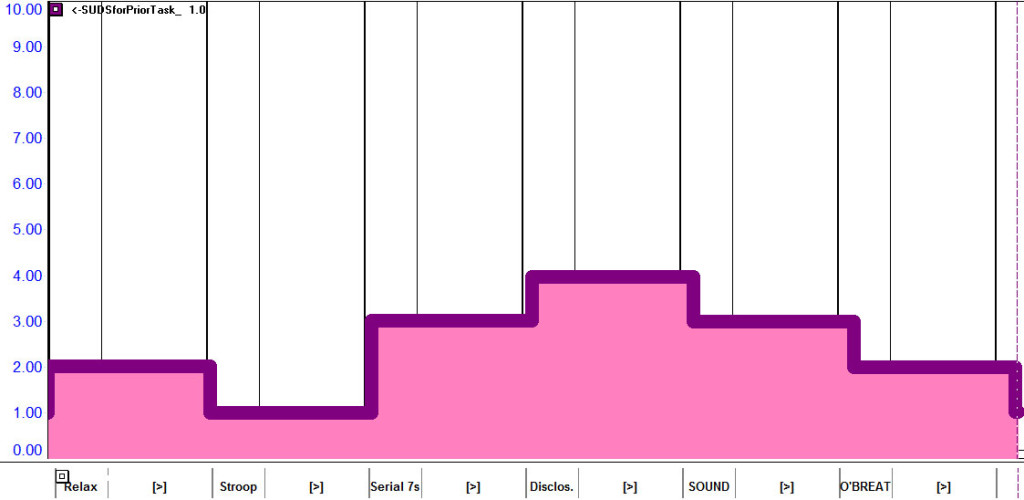
So how much distress did each challenge produce? This is estimated by the client on a scale from one to ten. In this case, disclosure was most stressful.
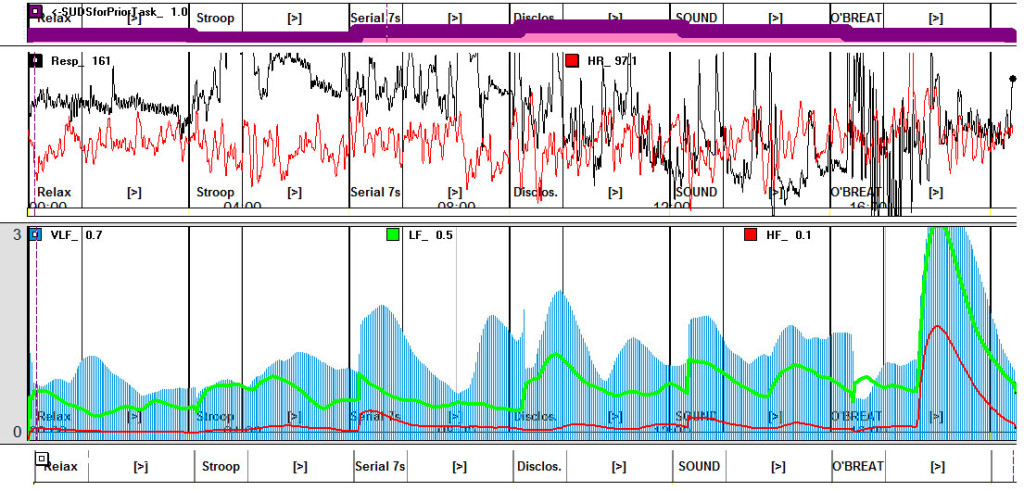
So did his stress profile fit with his physiological arousal? Respiration and heart rate patterns vary with each stressor and recovery period [>]. HRV reactivity and arousal never calms down. Basically this person shows extensive arousal in the Very Low Frequency range, consistent with excessive ruminations, even at rest during recovery. And VLF was elevated during Disclosure.
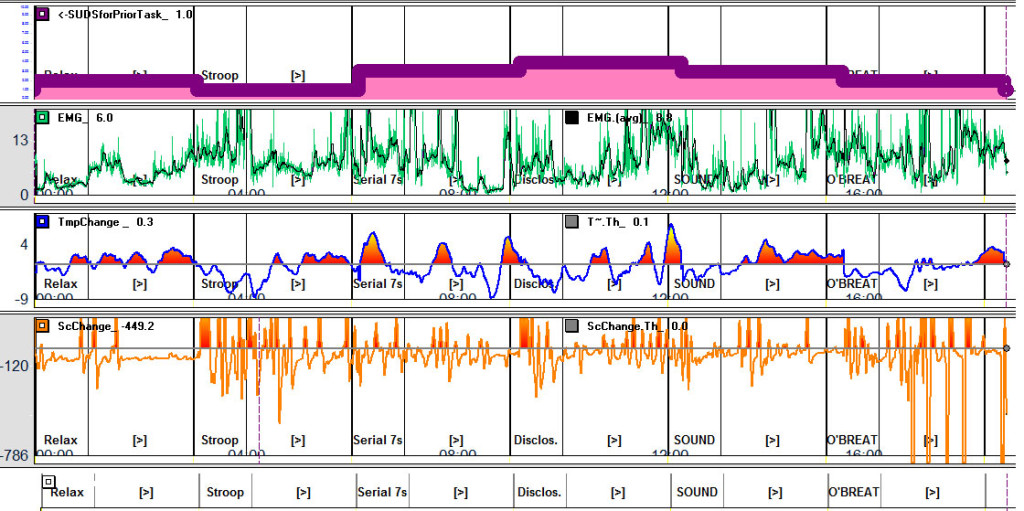
If we look at other signals, the expression of the arousal becomes clear. Note the EMG pattern in green. Basically EMG remains variable and often aroused during recovery, common in clients with chronic muscle-contraction headaches. And – not surprisingly, hand temperature and skin conductance also fail to calm down. This is a gateway to helping the client understand the need for biofeedback.
SPOKEN RELAXATION TRIALS
MINDFULNESS SCRIPTS
These apps monitor a person’s physiology while taking them through a selection of relaxations and mindfulness audio scripts. I use them to make sure that a client can benefit from at least one of these techniques outside the office.
SIMPLE SOMATIC BIOFEEDBACK APPS
Feedback combining SC – Skin Conductance- with mindful arousal-awareness exercises are helpful to educate clients about conditioned reactivity responses to stressful [and pleasant] thoughts, a great pre-cursor to dealing with intrusive thoughts during subsequent neurofeedback/biofeedback and/or desensitization-linked treatments.
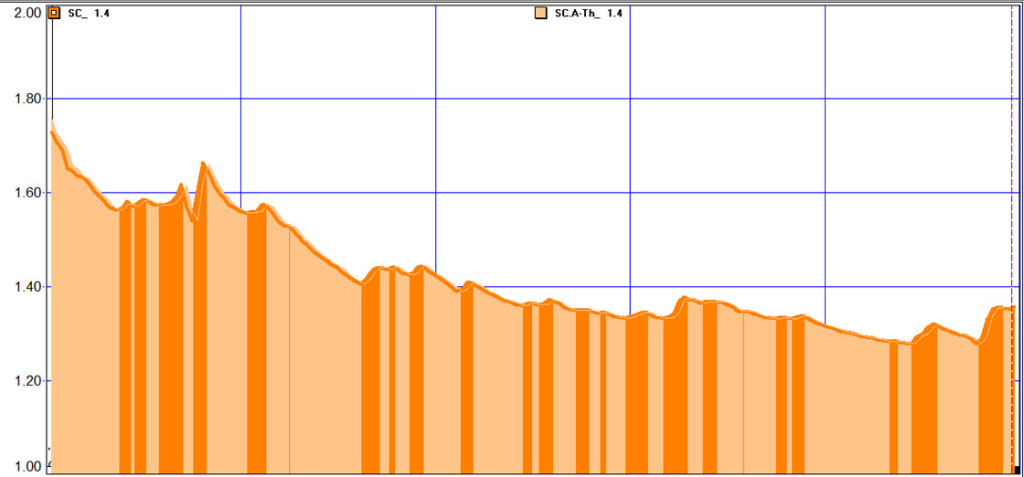
Solid segments show increased arousals; stippled segments show arousal reductions. This client learned to interrupt arousal-inducing thoughts within 5 seconds, below the threshold of awareness, a thought interruption technique from the 1980s.
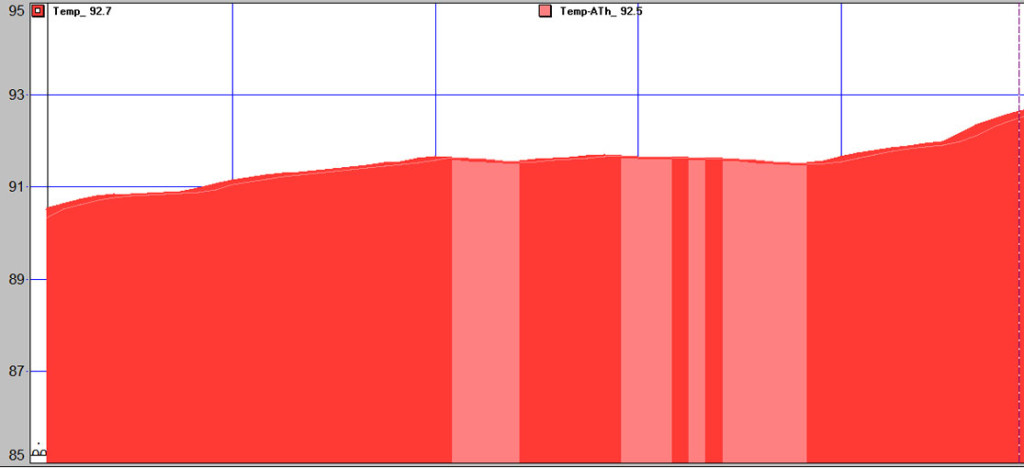
In order to warm your hands, you can’t maintain a stressful thought. Here is an example of learning to keep your hands warm while exploring stressful thoughts.
PACED RESPIRATION TRAINING
This simple program uses a respiration sensor to help instruct easy breathing training.

In this example, the client appeared to breathe well, but it was not a really ‘relaxed’ kind of breathing. Only in the beginning and at the end did he exhale completely, something that he later learned was optimal.
COACHING APPS
One of the biggest impediments to getting clinicians to apply neuropsychophysiology and biofeedback apps is training. After all, no one wants to stumble in front of a client. That’s why I include so many prompts and scripts with each application. This particular app provides scripts and reminders to help keep focus on the task at hand.
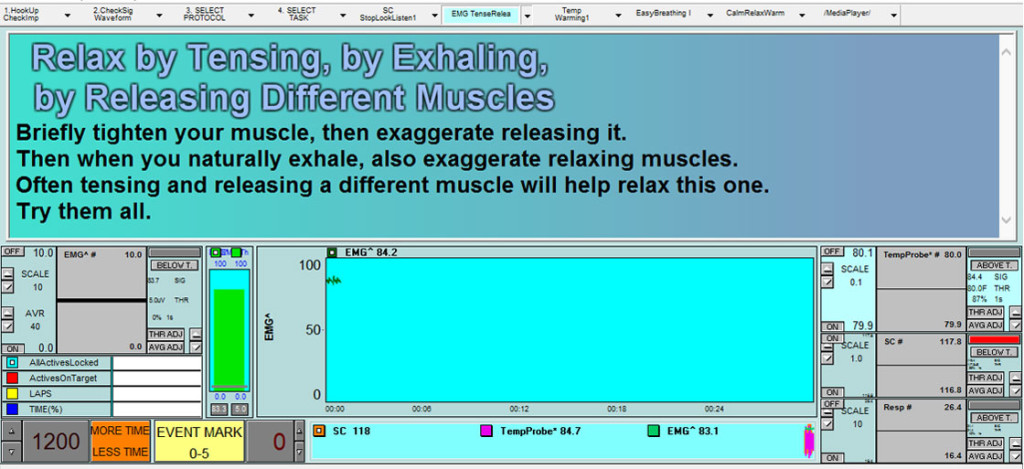
This screen provides instructions for learning awareness of EMG levels.
HRV APPS
Puzzled about HRV? I found a lot of misinformation about what it was, and how it helps cope with a variety of problems. So I invented an interactive app as a tutorial, Then I provide 3 variations of HRV apps, from simple ECG-HR only apps to full physiology apps to find a person’s resonant frequency, to incorporating HRV into EMG and other somatic feedback events.
An important variable is finding a person’s optimal breathing rate to maximize the HRV wave. Here is an example of an individual’s Resonant Frequency screen, using a pacer to match to breathing, and ECG-derived HR to evaluate optimal HRV amplitude.
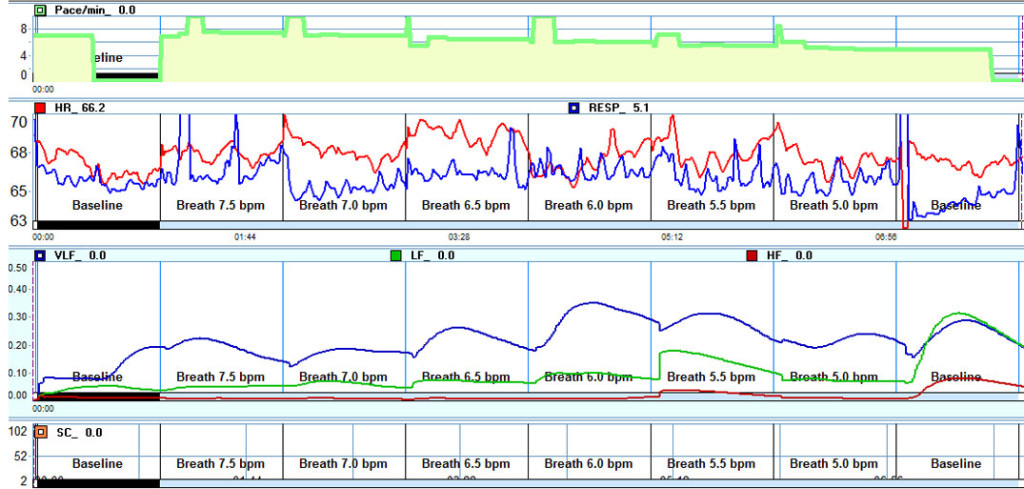
HRV Training is simple: select a breathing rate and prompt the client to match breathing rates without strain. In practice, HRV training is more complicated, the subject of another discussion.
EMG APPS
Remember, there is only one fast ExG sensor on the GP8-sc. So when EMG is monitored over specific sites contaminated by ECG waves, the software can be tweaked to attenuate the ECG, a nice feature for EMG work.
There are two EMG apps. On is for simple muscle relaxation, similar to other simple apps. The other is for neuromuscular awareness of both tension levels and complete release.
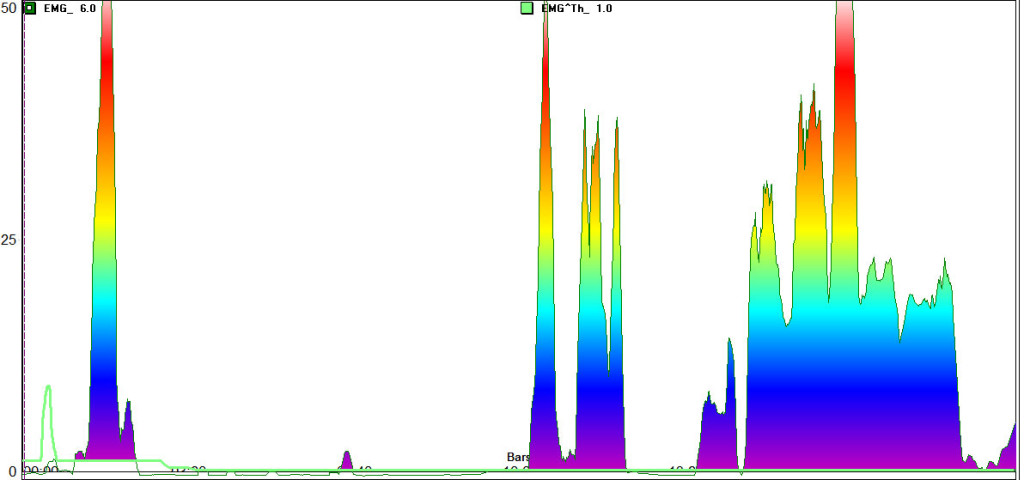
Here is a client learning to activate and release their EMG. At first, he was not good at activating an intermediate level of EMG tension, but towards the end, he got it and could hold it there for many seconds.
NEUROFEEDBACK
There are three NFB apps. One is for Alpha Theta Training, and includes a brief substance abuse-related set of pictures flashed on the screen to assess addiction reactivity.
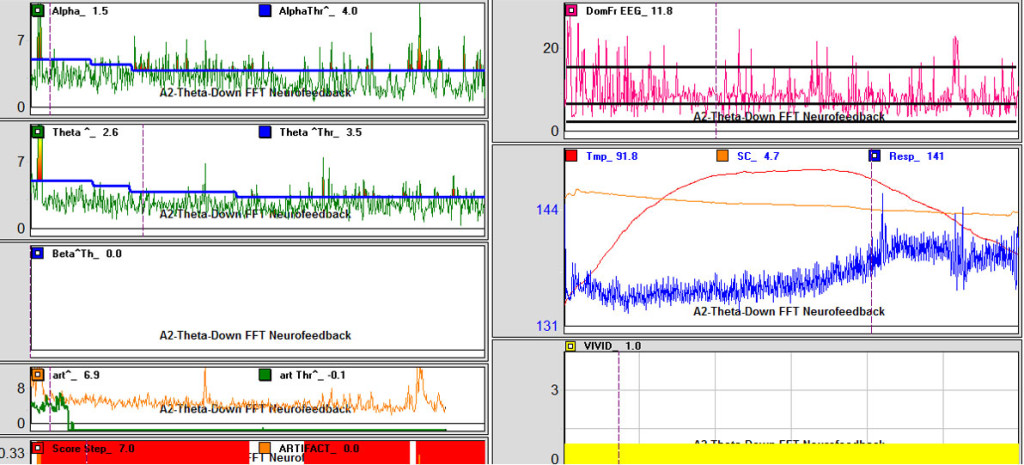
This is from a typical desensitization session. Initially calm in an alpha-theta state, when imagining a potential craving situation, somatic measures of arousal on the right indicated greater arousal, but still a rather calm brain-wave state.
The other NFB programs are for traditional 3 to 50 Hz Reward-Inhibit protocols. This NFB protocol is based on Sterman’s and Lubar’s 1990s research. One is a simple EEG Reward-Inhibit program that runs uninterrupted for a 20-minute session. The other is timed, with 3 minutes of feedback, then a pause with evaluation, repeated for about 25 minutes.
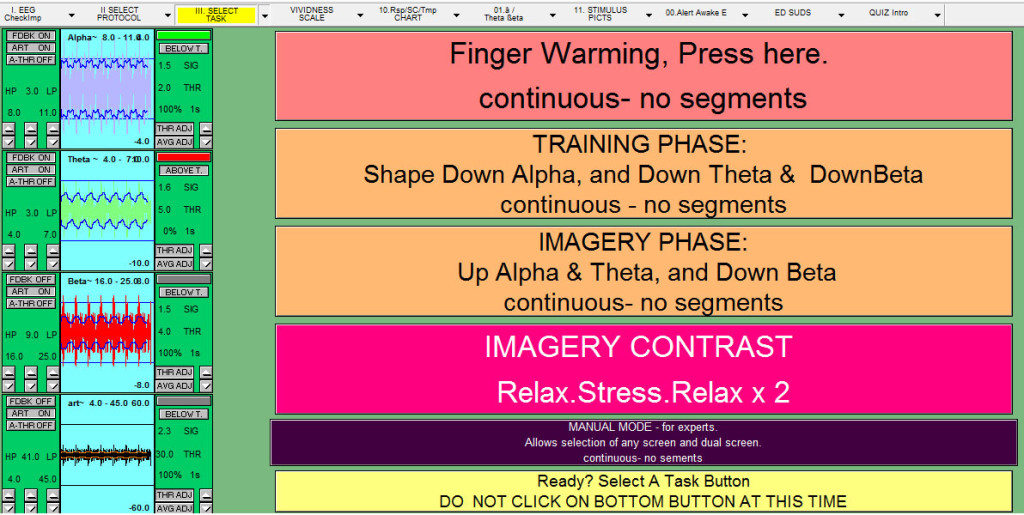

Basically these NFB protocols are dated, but still reliable. You can use them in a pinch, or to augment the Cygnet system.
I hope you found this helpful. Regardless of which instruments you choose, remember that you too are a feedback device for your clients. If you stay in the loop during training, and are involved and flexible, you are more likely to have positive outcomes. I have attempted to keep this in mind as the software has been revised and improved over the years.
Robert N. Grove, Ph.D.
P.S. For additional information, see click here.
The cost of the GP8-s is $535 plus applicable tax.
Orders should be sent to: physiolens@gmail.com
Questions may also be directed to Dr. Grove at drgrove@gmail.com





